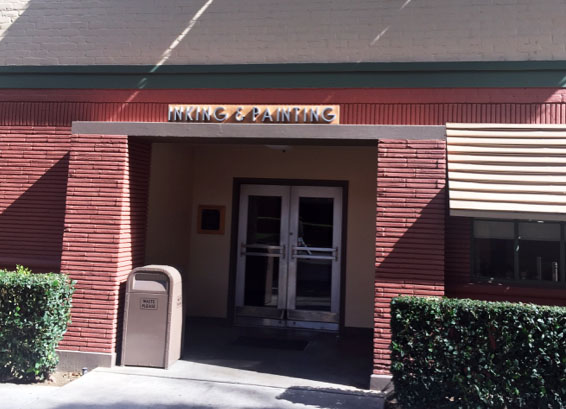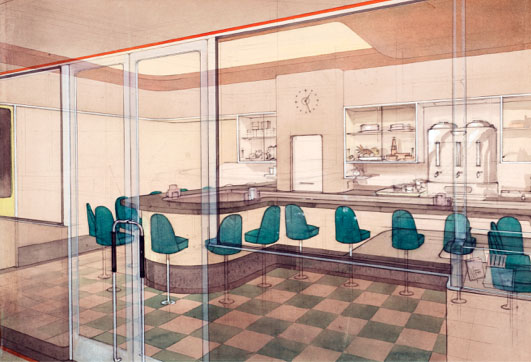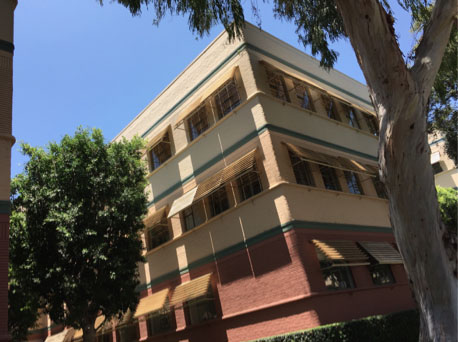
While writing Kem Weber: Mid-Century Furniture Designs for the Disney Studios, I jotted down some interesting facts about the Walt Disney Studio lot. These are points of interest that I either came across in my research or thought more about in regards to my own experiences exploring the Studio lot. If you worked at the Studio or visited for a tour you may or may not know these fascinating tidbits of information. So, without further ado here is my list of 5 Things That You Didn’t Know About the Disney Studio Lot in Burbank:
1. Walt Disney asked Kem Weber, chief designer of the Disney Studio lot in Burbank, to come up with a “bright, cheerful color scheme” for the exterior of the buildings. The color choices for the animation production buildings were made off of the California desert palette— beige/cream, green and red. The muted terracotta red was in contrast to the sandy beige/creams and the cactus greens that are seen throughout the desert landscapes of the American southwest. This color scheme and design style has been used in recent years on new construction including The Team Disney building in Burbank and a number of buildings at Walt Disney World and Celebration in Orlando.


2. Walt was so involved with the planning of the new studio that he left nothing undiscussed. With the campus being designed using different buildings for various parts of the animation process, one of his artists asked what you would do in rainy weather? After discussing how often it rained, Walt decided to add an underground tunnel connecting the animation building to the ink and paint/camera buildings. The tunnel was likely used early on but quickly turned into a place for storage. It also became known as the “Tunnel of Love” because of the apparent trysts that took place with the lights off. There are unverified stories that Walt occasionally went down and flipped on the lights to see if he caught any of those encounters.

3. The main Studio Theater was essentially a big beige box that was described as “utilitarian” and “plain.” To dress up the building, Weber designed a concrete surround, for the entryway, with circular holes and large brick corners on the building to give more visual interest. The entry edifice incorporated the design elements found throughout the complex—the circular holes mimicked the “portholes” of ships. It was part of the Streamline Moderne style that cued off of modern transportation of the day; steamships and airplanes. These elements can be seen throughout the property from door handles to stairway banisters to the soft curved walls. Sadly, some of those features have disappeared over the years with remodels and renovations.

4. In the utopian campus that Walt was trying to build, he wanted it to be all self-contained. Aside from having a Studio commissary where his employees could get a hot meal, he also included a coffee shop in the main animation production building. The coffee shop was on the first floor and was only there for a short while. Apparently, when Walt had walked past the café numerous times and noticed many of the same employees hanging out there, he had the café closed and torn out.

5. The main production building may look like a three story building from Dopey Drive or Mickey Avenue, but there is actually a fourth floor. The “Penthouse” is a smaller floor in area located on top of the building accessible by the center elevator. This was a men’s only club that had a gym, masseur, a barber and an outdoor sundeck for nude sunbathing or as they liked to say, “the all over tan.”. The Penthouse was for the senior male employees and also had a small lunch counter with service. In recent years, the space has been converted to offices currently occupied by part of the Studio’s Post Production group. Let’s face it, gender specific clubs are antiquated and likely illegal these days but it shows how progressive society has been in the ensuing years.

The Walt Disney Studio lot is a wonderful architectural gem that is a prime example of the Streamline Moderne style and early Mid-Century design. The entire campus, with the exception of the Roy O. Disney Building, has a common design thread that ties together the complex. From the specific color palette of the building exteriors to simple door pulls on glass entry doors to the long horizontals lines and soft curves throughout, there is a comfortable, simple and functional quality to the facility.
Aside from the buildings, what sets this Studio apart from all the others in Hollywood is the that the fifty-one acre property is tied together with beautiful and scrupulous landscaping that gives it a true college campus-like atmosphere. It shows that Walt was way ahead of his time in building a creative campus. Today, companies like Apple, Google and Amazon have done similar facilities but it all started at Disney. To learn more about Disney animation history visit: www.davidbossert.com


 David A. Bossert is an award-winning artist, filmmaker, and author. He received his B.A. from CalArts School of Film and Video with a major in Character Animation. As a 32-year veteran of The Walt Disney Company, he contributed his talents to The Black Cauldron (1985), Who Framed Roger Rabbit (1988), The Little Mermaid (1989), Beauty and the Beast (1991), Aladdin (1992), Tim Burton’s The Nightmare Before Christmas (1993), The Lion King (1995), Fantasia/2000 (1999), and the Academy Award-nominated shorts Runaway Brain (1995), Dali/Disney Destino (2003), and Lorenzo (2004), among many others. Bossert is now an independent producer, creative director, and writer.
David A. Bossert is an award-winning artist, filmmaker, and author. He received his B.A. from CalArts School of Film and Video with a major in Character Animation. As a 32-year veteran of The Walt Disney Company, he contributed his talents to The Black Cauldron (1985), Who Framed Roger Rabbit (1988), The Little Mermaid (1989), Beauty and the Beast (1991), Aladdin (1992), Tim Burton’s The Nightmare Before Christmas (1993), The Lion King (1995), Fantasia/2000 (1999), and the Academy Award-nominated shorts Runaway Brain (1995), Dali/Disney Destino (2003), and Lorenzo (2004), among many others. Bossert is now an independent producer, creative director, and writer.













































































I read about the trysts on the tunnel and the secret penthouse in Mindy Johnson’s Ink & Paint: The Women of Disney Animation. A great read, very informative.
Having worked at Disney for many many years I knew all the hiding places the under ground tunnels were great for having a crafty smoke I remember the gym the barber shop the grill and the bar atop of animation the old process lab next to the camera bldg before the frank g wells bldg was built
‘The tunnel was likely used early on but quickly turned into a place for storage. It also became known as the “Tunnel of Love” because of the apparent trysts that took place with the lights off.’
No doubt many encounters began with an offer to see a hidden Mickey.
During the 60s, the traffic boys on break would go down to the tunnel, spread a bunch of Fantasia or Dumbo cels on the concrete floor. Then they’d take turns running and sliding on them like a backyard water slide.
Oh god, that sounds amazing (and a little sad too)!
I used that tunnel on rainy days as a partial cut thru from Frank G Wells to the commissary…..never any sign of trysts tho. It wasn’t an environment to linger in.
The tunnel was also featured in many a TV and movie production, most notably the ABC TV show Alias, which filmed on the lot.
The tunnel can also be seen in a few episodes of the 1950s version of the TV series Dragnet. The series was filmed at the Disney lot. Sometimes other areas of the studio can also be seen.
By far, my favorite studio lot, mainly because it’s changed so little since its heyday.